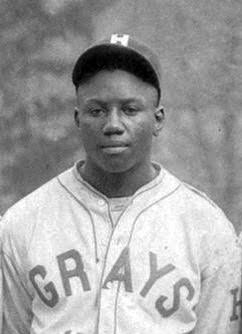Josh Gibson was born in 1911 in Buena Vista, Georgia. His family moved to Pittsburgh in 1923 after Gibson’s father was hired by the Carnegie-Illinois Steel Company. Gibson was an American Negro league baseball catcher. According to baseball historians, Gibson ranks among the very best power hitters and catchers in the history of any league, including Major League Baseball.
In 1972, he became the second Negro league player to be inducted in the National Baseball Hall of Fame. In 1998, The Sporting News placed Gibson at #18 for the 100 Greatest Baseball Players.
Like Honus Wagner, Gibson’s future career seemed to be decided at age 12. He enrolled in Allegheny Pre-Vocational School and Conroy Pre-Vocational School to prepare to become an electrician.
Gibson didn’t play organized baseball until he was 16. At the time, he was working as an elevator operator for Gimbels Department Store. Gimbels sponsored an amateur baseball team and Gibson became their third baseman. A short time later, He was recruited by The Pittsburgh Crawfords which were still a semi-professional team. However, the Crawfords were one of the top black semi-professional baseball teams and would be part of the Negro Baseball League by 1931.
Gibson continued to work at Gimbels, but he had given up on becoming an electrician in favor of a career as a professional baseball player.
In 1930, Gibson was 18 and he was recruited by the Homewood Grays, the top Negro League team in Pittsburgh. He made his debut with the Grays on July 31, 1930. Eleven days later, Gibson’s wife died giving birth to twins. The children, named Helen and Josh Jr. after their parents, were raised by Helen’s parents.
He played for the Grays from 1930-1931 before moving to The Pittsburgh Crawfords in 1932 where he played through 1936. Gibson returned to the Grays from 1937 through 1939 and later from 1942-1946. He played part of 1937 for Ciudad Trujillo in Trujillo’s Dominican League and from 1940-1941; he played for Rojos del Aguila de Veracruz in the Mexican League. Gibson was the first manager of the Santurce Crabbers of the Puerto Rican Baseball League.
Gibson was known as the “Black Babe Ruth.” In some circles, Ruth was called the “White Josh Gibson.” Gibson never got the opportunity to play Major League Baseball because of the unwritten gentlemen’s agreement to exclude players of color. In the mid-forties when Branch Rickey was looking for the first black baseball player to break the color barrier, many Negro League players felt Gibson should have been selected over Robinson. However, Gibson was diagnosed with a brain tumor in 1943 and refused surgery. On January 20, 1947, Gibson suffered a fatal stroke in Pittsburgh a few months before Robinson officially broke the color barrier on April 15 when he started at first base for the Brooklyn Dodgers.
Gibson is buried at the Allegheny Cemetery in Lawrenceville, PA. His grave was unmarked until 1975 when a small plaque was placed at his gravesite.
The US Postal Service issued a commemorative stamp of Gibson. In 2009, a statue of Gibson was placed inside the center field gate of National Park beside statues of Frank Howard and Walter Johnson. For his “significant contributions to the game of baseball in Washington, D.C. as a member of the Homestead Grays,” he was named to the Washington Nationals Ring of Honor in 2010.
Ammon Field in Pittsburgh where Gibson began his career playing for the Pittsburgh Crawfords was renamed the Josh Gibson Field and it has been designated with a Pennsylvania State Historical Marker.
Official stats for players in the Negro Leagues are sometimes hard to authenticate. The League had a shorter official schedule because teams routinely played exhibition games against semi-professional teams which were more profitable than regular league games. Many sports historians have questioned the validity of home runs scored against lesser competition. Also, many players of color played parts of their careers for leagues in other countries.
Researchers for the Special Committee on the Negro Leagues credit Gibson with 224 homers in 2375 at- bats vs top black teams, 2 in 56 at-bats vs white major league pitchers and 44 in 450 at-bats in the Mexican League.
During his 17 year career, Gibson won nine home run titles and four batting championships.
The 1930-31 Homestead Grays. Authorities on the Negro Leagues have made them the consensus pick as the best team ever. Standing: Cumberland Posey*, Bill Evans, Jap Washington, Red Reed, Smokey Joe Williams*, Josh Gibson*, George "Tubby" Scales, Oscar Charleston*, Charlie Walker, Jr. Kneeling: Chippy Britt, Lefty Williams, Jud Wilson*, Vic Harris, Ted "Double Duty" Radcliffe, Ambrose Reed, Ted Page. (*Hall of Fame)







